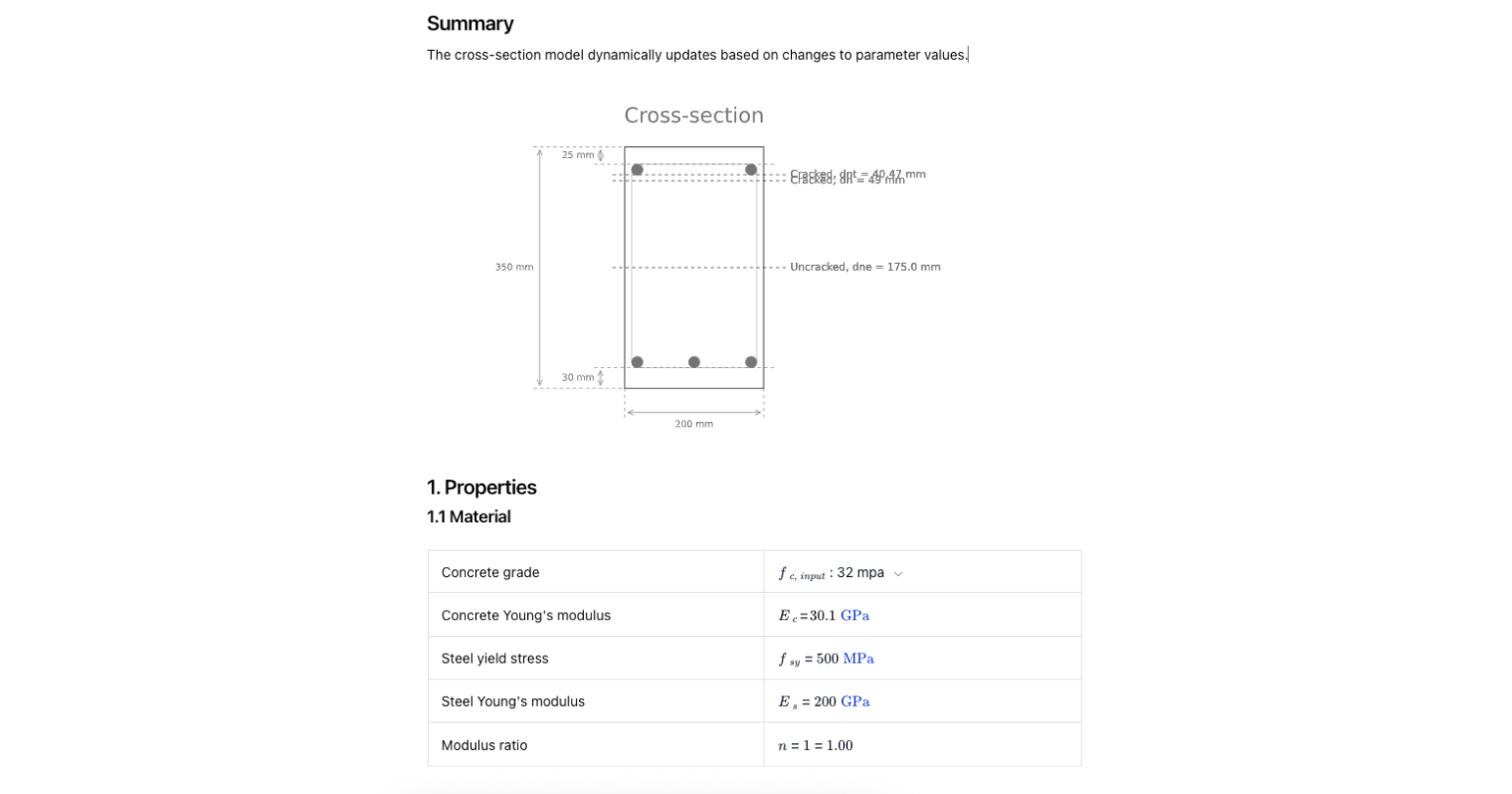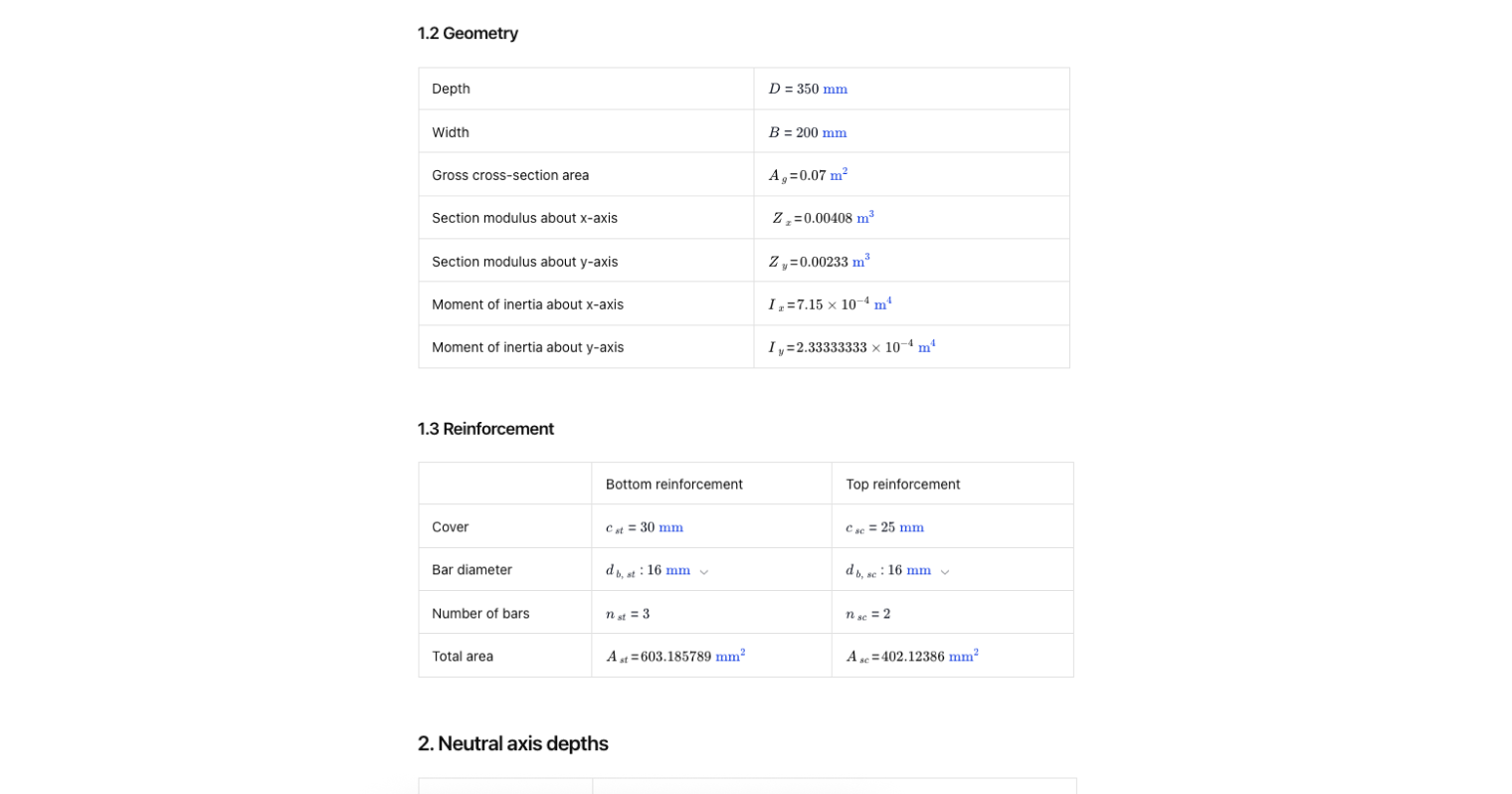Free Neutral Axis Calculator: RC Section to AS 3600:2018. Step-by-step, engineering-grade tool with downloadable report.

This template is not available yet. You can sign up and create it yourself!
Or let us know if you'd like to be notified when it’s ready:
About this Neutral Axis Calculator
This Neutral Axis Calculator: RC Section to AS 3600:2018 is built to determine the precise location of the neutral axis for reinforced concrete (RC) sections based on Australian Standard AS 3600-2018. It also calculates associated section properties like the moment of inertia, section modulus, and principal axes—essential for accurate structural design and bending checks.
- Structural Engineer: uses the calculator to verify the elastic section modulus, locate the plastic neutral axis, and determine axial and bending capacities of RC beams or columns.
- Civil Design Consultant: applies the tool to assess cross section efficiency, including the principal axis orientation and moment behavior for non symmetric sections under load.
- Engineering Drafter: inputs section dimensions such as flange thickness, web thickness, and shape width to verify alignment with structural assumptions and documentation.
This is an engineering-grade calculator that supports analysis of complex shapes and inputs in the same units across all dimensions. It automates a process that typically involves tedious hand calculations for moment of inertia, neutral axis depth, and section modulus for each axis.
General Info on Neutral Axis and RC Section Properties
What is the Neutral Axis?
The neutral axis is the location within a cross section where the bending stress is zero. Above and below this axis, the material transitions between compression and tension. The elastic neutral axis is calculated using first moments and elastic section properties, while the plastic neutral axis is defined based on the full stress block during plastic bending.
In reinforced concrete design to AS 3600, this is critical in defining the limit states for design and ductility.
Moment of Inertia and Second Moments
The moment of inertia quantifies the stiffness of a shape when subjected to bending. For both x axis and y axis, the second moment defines resistance to bending deformation. A higher moment of inertia means lower curvature for a given bending moment.
Common shapes such as rectangles, T-sections, and channel sections have known moment of inertia equations, this calculator works specifically with rectangular shapes.
Section Modulus
The section modulus is derived from the moment of inertia divided by the distance to the outermost fiber. This is vital for calculating maximum stress in bending. The calculator outputs the elastic section modulus along each principal axis.
Cross Section Inputs and Material Parameters
Users enter section dimensions (width and height) along with material properties like Young’s modulus. The cross sectional area, centroidal position, and shear centre are automatically calculated. This improves consistency and ensures the tool calculates properties along the correct centroidal axis and same axis used in structural design.
Common Calculation Errors to Avoid
- Forgetting to align inputs with the principal axis can lead to incorrect stress and deflection predictions in design.
- Mixing units for moment, distance, or modulus results in inaccurate section modulus or moment of inertia calculations. Always use the same units.
- Incorrectly placing the neutral axis in non symmetric sections will throw off bending stress distributions.
- Assuming the x and y axes are the same as the principal axes—this is only valid for symmetric sections.
- Using elastic formulas when plastic behavior governs—especially critical when determining plastic neutral axis and capacity.
Engineering templates
Common calculators
Design guides
FAQs
How does this tool calculate the neutral axis?
It uses the first moments of area and section properties to determine the neutral axis location, referencing AS 3600 for stress block and material assumptions. It supports both elastic and plastic approaches depending on the section type.
Can I use this calculator for a non-rectangular beam shape?
No, the calculator only supports common shapes. It processes the cross section based on input dimensions, computes the moment of inertia, and identifies the principal axis orientation automatically.
Is the section modulus calculated for the x or y axis?
The calculator determines section modulus for both x axis and y axis.
What other section properties are included in the results?
The tool provides calculations for:
- Uncracked, linear-elastic section
- Cracked, linear-elastic section
- Cracked, non-linear elastic section
- Support for inertia calculator output and section modulus calculator data
What factors influence the location of the neutral axis in a concrete section?
Several factors affect the neutral axis location, including concrete strength, reinforcement placement, section geometry, and the type and amount of load applied to the section.
How does reinforcement placement affect the neutral axis in a concrete section?
Reinforcement placement directly influences the tensile capacity of the section, which affects where the neutral axis falls under load. Proper reinforcement design can optimize section performance by controlling the depth to the neutral axis.
What is the significance of the nonlinear elastic stage in concrete design?
The nonlinear elastic stage considers the material’s realistic behavior under stress, beyond idealized linear models. This stage provides a more accurate understanding of the concrete’s response under larger loads, aiding in safer, more reliable designs.
Summary and References
This neutral axis calculator for RC sections to AS 3600:2018 is an efficient tool for structural engineers needing reliable section properties for bending, shear, and axial strength checks.
It automatically determines the neutral axis, computes moment of inertia, and evaluates both elastic and plastic section modulus. Designed to streamline calculations for beams and columns with varying geometries, this calculator ensures compliance with Australian standards and practical clarity in design workflows.
Reference:
- Australian Standards Concrete Structures AS 3600:2018
Explore other structural engineering tools and resources further below.
Learn about the benefits of using CalcTree on engineering projects!












